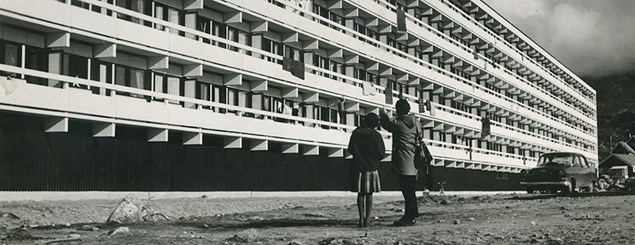Block P
The final tribute
Block P is no more. But the myth surrounding what was once the largest residential complex in the Danish Commonwealth lives on, and the power of attraction the controversial Colossus had, was in no way diminished when its last wall came down in 2012. This final tribute also bears testimony to the fact that the block is still fascinating and very much alive.
The block was constructed in 1965-66 as a large, white, alien giant. Its vast scale overshadowed Nuuk's many colourful wooden buildings and became a symbol of Denmark's administration of the country. Block P was a Danish, bureaucratic solution, which implemented the policy of urbanisation and concentration, for which not only Danish, but also Greenlandic national congress politicians, had paved the way in the 1950s and early 1960s [1]. One of the objectives of this policy of modernisation was to depopulate the settlements, where educational opportunities were inadequate and housing conditions poor or primitive.
In other words, the solution to a whole range of post-war, social challenges in Greenland was to "export the Danish welfare state to Greenland" in the shape of the blocks of flats, which shot up at lightning speed in big towns. It was a type of housing that instantly improved living conditions and provided the new residents with modern comforts such as running water, sanitation and decent kitchens, not to mention shops and schools on their doorstep. But it was also a type of housing that originated in a decidedly different social structure from that which most of the residents came from: a hunting, fishing society. For those of them who found it particularly difficult to adapt to the new conditions, the move had major personal and social costs and negative consequences.
Block P is rich in a multitude different sorts of stories: not only about the policy of modernisation and colonialism, life in the ghetto and social decline, but also about those people who had no problem dealing with the upheavals. Their lives were enriched with more opportunities. Life itself became safer, and they became part of a large, social cohesiveness and secure upbringing.
Because of this social diversity and the various societal contrasts, Block P was, throughout most of its lifespan, a source of fascination, which attracted not only its own residents, but also tourists, academics, artists, photographers and many others. All the people involved in BLOCK P - The Final Tribute also became fascinated. With a variety of approaches and points of view, and independently of one another, they were drawn into the strange destinies and tales of Block P, creating projects that cover social geography, film, anthropology, journalism, colonial history, cultural history, architecture and town planning.
The exhibition is a kaleidoscopic portrait of Block P. It uses documentary evidence from former residents about the demolition process and the remaining traces of life and existence, in an attempt to view the building from a variety of angles and perspectives. They help to recollect and confirm the countless functions and meanings of the block throughout the 46 years of its existence.
